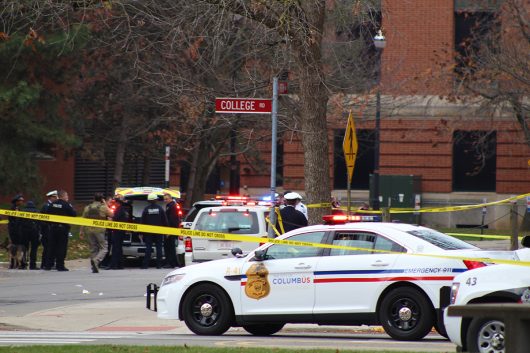
Columbus Police, University Police, the FBI and the Bureau of Alcohol, Tobacco and Firearms cordon off the area between College Road and 19th Avenue following an attack on OSU’s campus on Nov. 28. Credit: Mason Swires | Assistant Photo Editor
After a car-and-knife attack hospitalized 11 people at Ohio State on Monday, University President Michael V. Drake praised the OSU community’s readiness to act and respond to the incident. In a news conference Monday, Drake said OSU students, faculty and staff train every year for situations like Monday’s attack, given their prevalence across the country.
Some OSU students, however, said that while they were thankful for the university’s prompt response and contact with students, they didn’t feel entirely prepared to respond to an active-shooter situation due to a lack of clear communication and emergency training from the university.
Cailin Pitt, a fifth-year in computer science engineering, said that when he got the Buckeye Alert message around 10 a.m., he was in Scott Laboratory –– a building only a block away from Watts Hall, the location of the attack.
Pitt said he felt the initial Buckeye Alert message was “pretty vague,” only warning students to shelter in place. It wasn’t until a second text was sent that warned students of an active shooter in the area of 19th Avenue and College Road that he went to hide. The text also informed them to “Run Hide Fight,” a phrase coined by the City of Houston on how to respond during an active-shooter situation.
With a push of a single button, OSU officials can send out Buckeye Alerts tailored to multiple situations. Officials say this new system saves time, but it doesn’t involve someone typing out the specific details for that initial message, which in this case involved the initial alert being sent within about two minutes of receiving the report of the incident. Subsequent messages then include more details as they become available.
“I wasn’t going to do anything about it because I didn’t understand what they were saying, so I went to Twitter to see if the official (@OSUPOLICE) account tweeted anything,” Pitt said. “On Twitter, I saw that it said, ‘Active shooter. Run Hide Fight.’ That’s when it hit me that it was real and I was really scared.”
Pitt said he went to hide in the safest place he could think of: the bathroom. He hid in a bathroom stall in Scott Laboratory for two hours.
“During those two hours, OSU sent out a couple of alerts and updates, but I didn’t feel like I knew what was going on. So I was monitoring Twitter the whole time, following all the local news and getting my updates from that,” Pitt said.
Pitt said he stayed in the bathroom until a follow-up Buckeye Alert message said the shelter-in-place order had been lifted, but went back after hearing from students and social media that police were still urging students to stay in place. He then stayed there for an additional 20 minutes before leaving.
Pitt said it is good that OSU uses an alert system to notify students of emergencies, but he was disappointed in the texts’ lack of clarity.
“For the original text message, I did not feel prepared at all because I didn’t know what was going on. But once I saw the active-shooter alert, my internal instincts kicked in to go somewhere safe,” Pitt said. “I think the message of ‘Run Hide Fight’ isn’t great. It’s something I realized when I was an RA. I don’t want to fight anybody. I just want to be safe.”
Although “Fight” is last command in “Run Hide Fight,” the protocol encourages students to first try to run away from the area, hide in a secure space if they cannot leave and then, only as a last resort, fight off the active shooter.
During the 2015-2016 academic year, OSU released a video called “Surviving an Active Shooter,” which was produced to educate the campus community on what to do in active-shooter situations, said Dan Hedman, spokesman for the Office of Administration and Planning at OSU. The video had more than 335,000 views on YouTube as of Tuesday.
Bree Crye, a fifth-year in journalism and political science, said that she had never heard of the video until after the incident when a friend posted it on Facebook.
“It’s funny because I know there’s a video of the ‘Run Hide Fight,’ but I didn’t even know it existed until it happened. I think it’s kind of funny how it takes a situation like this happening for everybody to learn what to do,” Crye said.
Other students said they felt prepared responding to an active-shooter situation. Kiara Brown, a fourth-year in international studies, said she is familiar with emergency situations like the events of Monday because of her public-school experience in Cleveland.
“I’m from Cleveland public schools, so we’ve had active shooters and I’ve been in situations where we’ve had to be safe,” Brown said. “I can’t even imagine what it would have been like to have never been around this stuff.”
Hedman said in an email that the safety of the campus community is OSU’s top priority and that the university takes a number of steps, from the Buckeye Alert notification system to sending students annual safety reports, to ensure Buckeyes’ safety.
“Police train countless hours to be prepared for emergency situations and are ready to respond, as needed, to protect the campus community in any emergency situation,” Hedman said. “Our OSU police officers undergo active-shooter training on an annual basis, and our Special Response Team receives additional training for various emergency situations.”
Crye said that being proactive and educating oneself on how to respond in emergency situations is important to being prepared, but that it is hard to know for sure what will help.
“I think that, in theory, we all feel like we’re prepared. But when something actually happens, it’s a completely different story,” Crye said. “Things like this happen, but you don’t think that it’s going to happen to you until you’re in that situation.”


